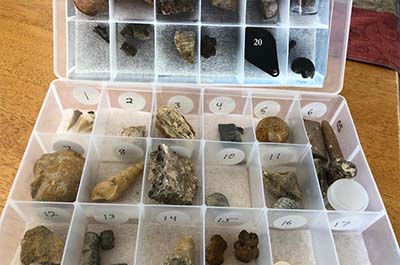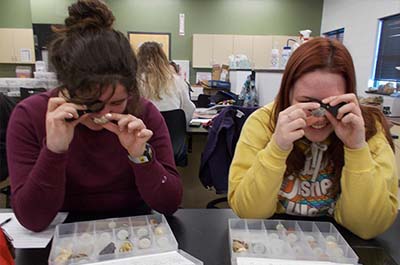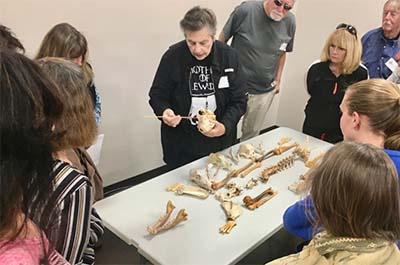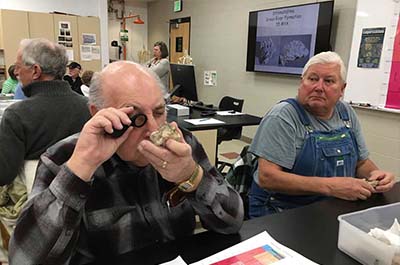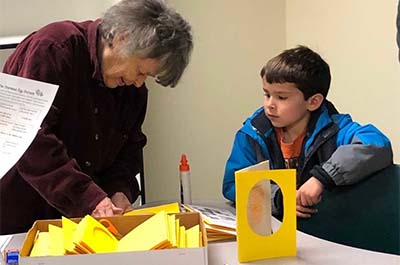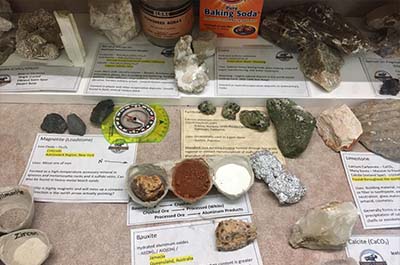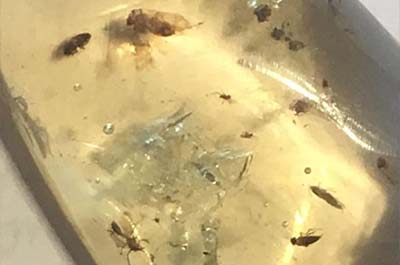2018 – Fossil Boot Camp 101
Stones ‘n Bones reached more than 40 community members interested in the introductory Fossil Boot Camp classes offered to the Cañon City Geology Club (CCGC) and to the PCC Mini-College in March of 2018. Students with no familiarity with fossils joined others who had already been bitten by the fossil bug in a morning of fossil immersion. Some students take the class over and over. Many request a Fossil Boot Camp 102, which we are working on.
CCGC members graduated from Fossil Boot Camp
In Fossil Boot Camp, students get hands experience with 18 different fossils in their own fossil kits, learning the anatomy, diversity, age, and importance of these creatures of the past.
In addition to the fossil kits and lockers, participants study the Stones ‘n Bones fossil collection with emphasis on illustrating ammonite sutures, trilobite genal spines, the serrations on a 4.25″ megaladon tooth, the cellular structure of dinosaur bones (complete with legal papers from the State Paleontologist’s desk), and polished and unpolished Wyoming turritella agate. Details of the familiar snail’s intricate anatomy helps students appreciate these common creatures.
Fossils aren’t just a fascinating hobby; they provide information on our ancient landscape through their contribution to the study of Paleogeography, which determines the location of continents and ocean basins in Deep Time. Similarities in trilobite species have supported the reconstruction of past continental positions due to plate tectonics, such as the physical proximity of Oklahoma and Morocco 380 million years ago. The use of fossils in Biostratigraphy aids in the correlation of rock strata in widely diverse locations and is sometimes the only way to age certain rock layers.
Fossil kit for individual study
Responsible collecting is emphasized, with focus placed on protecting our fossil resources and the importance of documenting fossil collections to preserve their scientific value. But the most important take-away is an appreciation of these rare and fragile creatures that we have the good fortune and opportunity to study and honor
More Articles from “Stones ‘n’ Bones Activities”
Fossil Boot Camp – Covid Style
Stones ‘n Bones of Fremont County traditionally presents two or three Fossil Boot Camp classes each year for school age students and adults. With COVID, that has proven a little difficult
Fossil Boot Camp for PCC Historical Geology Students
Fremont Stones ‘n Bones introduced 16 Pueblo Community College students to fossils in Steve Wolfe’s Historical Geology class.
Stones ‘n’ Bones With Villa Bella School’s 2nd Graders
“What do paleontologists do?” is the question we were asked to help answer for 50 second graders at Pueblo, Colorado’s newest elementary school on January 16, 2020.
The Close Relationship Between Man & Dog
Dr. Sue Ware returned to the Royal Gorge Dinosaur Experience for the second time, to the delight of 27 community members. She presented a program entitled “From your Campfire to your Bed: The Evolution, Importance & Relationship between Dogs and Humans”.
Fossil Boot Camp at PCC Mini-College
For the 5th straight year, Stones ‘n Bones presented Fossil Boot Camp to 31 senior citizens in the Fremont County community.
Stones ‘n’ Bones & the Enormous Egg
What happens when an entire elementary school reads the same book, The Enormous Egg, and asks Fremont County Stones and Bones to come in to help with the family night to celebrate the reading? A two-hour evening full of paleontology learning!
Introducing Geology Students to Fossils
How does Steve Wolfe, Historical Geology instructor at PCC-Fremont Campus, prepare his students for field season observations? One way is by introducing them to fossils
Identifying Trilobites
The Pioche Formation of eastern Nevada is world famous for its amazing preservation of trilobites. Very old trilobites, from the Lower Cambrian (542 – 521 million years old), almost the oldest on record.
Everything Begins With Mining
There are many ways to appreciate rocks. Many of us notice them simply for their color, texture and shape, irresistible and raw in nature.
Insects Trapped in Amber
Many of us are familiar with the high preservation of insects and leaves in the Green River Formation, a Colorado lagerstätte well known for field trips yielding magnificent fossils.

